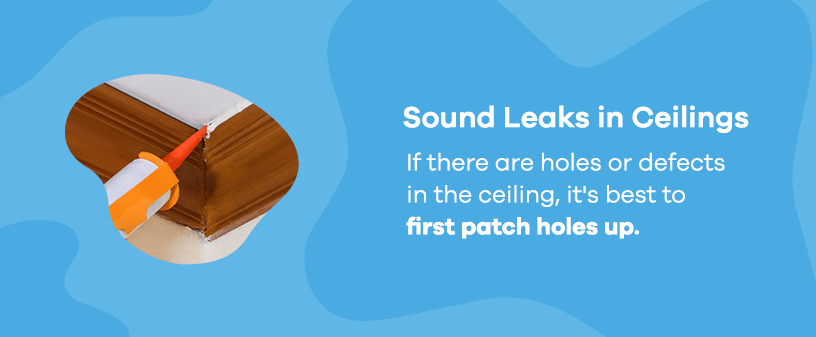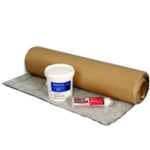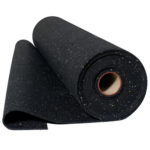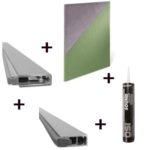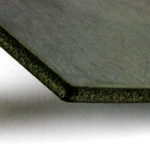
Soundproofing your home does more than create a peaceful and private environment — installing acoustic insulation materials can actually boost property value and even improve energy efficiency. These materials help make your home more peaceful while offering insulation, meaning you’ll spend less on energy bills and enjoy a far more tranquil environment.
Residential soundproofing comes with a few challenges, including purchasing the wrong products and encountering sound leaks. Investing in the correct sound absorption and soundproofing products is essential for proper sound control. Following the Installation Instructions is critical to the materials functioning properly. You also need to find and fix sound leaks.
If you have successfully installed the appropriate soundproofing materials and are still wondering where that noise is coming from, here’s everything you need to know about finding and fixing sound leaks.
What Is a Sound Leak?
When you hear a sound in a situation where you shouldn’t hear a sound, that’s a sound leak. For example, if you’ve installed soundproofing materials in your home office and can still hear noises coming from the kitchen, there’s a sound leak somewhere. Or, if you haven’t added soundproofing materials but one room in your home is louder than the others, there’s likely a sound leak.
A number of different problems can cause sound leaks. More often than not, thin walls are the culprit. Brick and block walls are good options for blocking sound leaks, and gypsum-based drywall also has a high capacity for sound absorption. With the right soundproofing materials, you can reduce noise leaks even in rooms with thin walls.
Wall thickness is not the only cause of sound leaks. For example, when the walls of a room don’t join with the true ceiling, sound can leak through the gap. This defect is not visible, so it can be tricky to detect. Cracked walls, AC ducts, gaps along wall edges and misshapen cut-outs are also faults that can cause sound leaks.
But how can you accurately identify where sound is leaking from?
How to Find Where The Sound Leak is Coming From?
Sometimes, locating a sound leak is as simple as identifying where sounds are the loudest in a room. By listening carefully, you should be able to tell where sound is seeping through. If you can’t figure out where the sound is louder, getting a sound pressure level (SPL) meter could help. Basically, this device measures the intensity of noise in a specific location.
With an SPL meter, you can accurately detect where sound is coming from and where sound leaks are the loudest. Whether the sound is leaking through one spot or several, this device makes identifying weak spots in soundproofing much easier.
Sound Leaks in Ceilings
Incomplete wall height leaves a gap where the wall and ceiling should meet. When walls attach to the false ceiling just below the true ceiling, a sound can seep through the small gap. This defect is impossible to see, so you’ll need to find out if your home has a mock ceiling or a secondary ceiling constructed below the original or true ceiling.
If the sounds come through the ceiling from an upstairs room, you can install flooring underlayment on the floor above the ceiling. Underlayment materials will dampen sound vibrations coming from the room above. If there is no room above, you can install soundproof panels on the ceiling. However, if there are holes or defects in the ceiling, it’s best to first patch holes up with heavy gypsum board and seal cracks with caulk.
Sound Leaks in Floors
If you have located sound leaks in the floor emerging from the room below, installing flooring underlayment is the best course of action. Flooring underlayment and soundproofing material sheets can help block out sounds. The type of flooring in your home will influence which soundproofing materials you should use:
- Hardwood floors: PROFLEX™ 90 is a suitable soundproofing material for this type of flooring. The Impact Barrier QT Flooring Underlayment is also an excellent choice for most types of flooring, including hardwood flooring. This soundproofing material uses advanced sound blocker technology that ensures moisture resistance to prevent mold and mildew growth.
- Laminate and composite flooring: The Impact Barrier QT Flooring Underlayment is also the best choice for laminate and composite flooring types.
- Ceramic tile and stone: PROFLEX™ 90 is an ideal solution for use beneath ceramic tile and stone flooring.
Flooring underlayment products are designed to prevent sound leakage from rooms below. This soundproofing layer must always be installed below your flooring for optimal results.
Sound Leak in Walls
It is essential to inspect walls carefully to ensure they are completely connected — there should be no spaces between perpendicular walls. Even the smallest space can compromise your soundproofing efforts. First, ensure the wall extends to the ceiling deck. Commercial walls often stop just above the drop ceiling allowing sound to travel through the opening between the top of the wall and the ceiling. After that, inspect the walls for gaps such as electrical outlets and switch boxes.
If there are gaps in the walls, sound can leak into the room. Carefully inspect the walls for airflow and ensure a strong seal on the floor. Feel along the floor for air movement and check for dust movement that signifies a weak seal. You might need to pull back the wall trim to inspect the seal properly and look for spots of missing caulk. If you notice any gaps or flaws in the caulk, sealing these can stop noise leaks.
If there are no defects in the walls and seals, the problem might simply be a lack of wall mass. If the walls are too thin, using an extra layer of sound-blocking drywall is best. Otherwise, you can reinforce walls with bulk mass loaded vinyl (MLV) material sheets. The additional lawyer will reinforce the walls to dampen sound leaks.
Sound Leaks in Doors
More often than not, doors are the culprit for letting in unwanted sounds into your home. Because most doors are hollow inside, they don’t provide much insulation. Hollow core doors are also made from thin panels that can’t effectively block out sounds.
The best approach is to invest in solid core doors. These doors use more material and are more dense, heavier, and better at blocking sound. However, you will still need to tend to gaps between the door and the door frame where sounds can travel through. You can use a door sealing kit to eliminate significant gaps in doorframes.
Request a Free Acoustic Analysis or Purchase Sounding Proofing Materials
Residential soundproofing has so many valuable benefits. Whether you need to reduce noise disturbances in your home office, soundproof a home studio, or simply enhance insulation and amplify peace and quiet in your living space, a variety of residential soundproofing products can help you transform your home into a peaceful sanctuary.
Contact Soundproof Cow for a free acoustic analysis, or visit our site to find the right soundproofing materials for your home. Fill out the soundproofing questionnaire to solve your noise complaints today!



